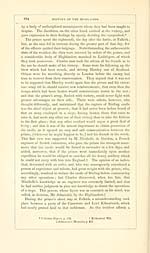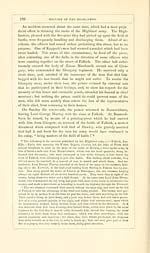Download files
Complete book:
Individual page:
Thumbnail gallery: Grid view | List view

BEMAHKABLE INSTANCE OF CLANSHIP. 195
remarkable illustration of clanship, the particulars cannot fail to bt
interesting. Loril Kilmarnock, having passed the evening of the battle
in his house at Callander, came next morning to Falkirk with a part^
of his men, who had in their custody some Edinburgh volunteers, who,
having fallen behind Hawley's army in its march to Linlithgow, had
hcen taken and curried to Callander house. Leaving the prisoners and
their guard standing in the street, opposite to the house where the
prince lodged, his lordship went up stairs and presented to him a list of
the prisoners, among whom was Mr Home, the author of the Tragedy
of Douglas and the History of the Rebellion. Charles opened the
window to survey the prisoners, and while engaged in conversation
with Lord Kilmarnock about them, as is supposed, with the paper in
his hand, a soldier in the uniform of the Scots Royals, carrying a musket
and wearing a black cockade, appeared in the street, and approached
towards the prince. The volunteers who observed this man coming up
the street were extremely surprised, and, thinking that his intention in
coming forward was to shoot the prince, expected every moment to see
him raise his piece and fire. Observing the volunteers, who wore within
a few yards of the prince, all looking in one direction, Charles also look-
ed the same waj', and seeing the soldier approach appeared amazed, and,
calling Lord Kilmarnock, pointed towards the soldier. His lordship
instantly descended into the street, and finding the soldier immediately
opposite to the window where Charles stood, the earl went up to him,
and striking the hat off the soldier's head, trampled the black cockade
under his feet. At that instant a Highlander rushed from the opposite
Bide of the street, and, laying hands on Lord Kilmarnock, pushed him
violently back. Kilmarnock immediately pulled out a pistol, antl pre-
sented it at the Highlander's head ; and the Highlander in his turn
drew his dirk, and held it close to the earl's breast. They stood in
this position about half a minute, w hen a crowd of Highlanders rushed
in and drove Lord Kilmarnock away. The man with the dirk in hij
hand then took up the hat, put it on the soldier's head, and the High-
landers marched ott' with him in triumph.
This extraordinary scene surprised the prisoners, and they solicited
an explanation from a Highland officer who stood near them. The
officer told them tliat the soldier in the rojal uniform was a Cameron:
" Yesterday," continued he, " when your army was defeated he joined
his clan; the Camerons received him with joy, and told him that he
should wear his arms, his clothes, and every thing else, till he was pro-
vided with other clothes and other arms. The Highlander who first
interposed and drew his dirk on Lord Kilmarnock is the soldier's
brother ; the crowd who rushed in are the Camerons, many of them his
near relations ; and, in my opinion," continued the officer, " no colonel
nor general in the prince's army can take that cockade out of his liat,
except Lochiel himself.*
• Home's Works, vol. iii. p. 162.
remarkable illustration of clanship, the particulars cannot fail to bt
interesting. Loril Kilmarnock, having passed the evening of the battle
in his house at Callander, came next morning to Falkirk with a part^
of his men, who had in their custody some Edinburgh volunteers, who,
having fallen behind Hawley's army in its march to Linlithgow, had
hcen taken and curried to Callander house. Leaving the prisoners and
their guard standing in the street, opposite to the house where the
prince lodged, his lordship went up stairs and presented to him a list of
the prisoners, among whom was Mr Home, the author of the Tragedy
of Douglas and the History of the Rebellion. Charles opened the
window to survey the prisoners, and while engaged in conversation
with Lord Kilmarnock about them, as is supposed, with the paper in
his hand, a soldier in the uniform of the Scots Royals, carrying a musket
and wearing a black cockade, appeared in the street, and approached
towards the prince. The volunteers who observed this man coming up
the street were extremely surprised, and, thinking that his intention in
coming forward was to shoot the prince, expected every moment to see
him raise his piece and fire. Observing the volunteers, who wore within
a few yards of the prince, all looking in one direction, Charles also look-
ed the same waj', and seeing the soldier approach appeared amazed, and,
calling Lord Kilmarnock, pointed towards the soldier. His lordship
instantly descended into the street, and finding the soldier immediately
opposite to the window where Charles stood, the earl went up to him,
and striking the hat off the soldier's head, trampled the black cockade
under his feet. At that instant a Highlander rushed from the opposite
Bide of the street, and, laying hands on Lord Kilmarnock, pushed him
violently back. Kilmarnock immediately pulled out a pistol, antl pre-
sented it at the Highlander's head ; and the Highlander in his turn
drew his dirk, and held it close to the earl's breast. They stood in
this position about half a minute, w hen a crowd of Highlanders rushed
in and drove Lord Kilmarnock away. The man with the dirk in hij
hand then took up the hat, put it on the soldier's head, and the High-
landers marched ott' with him in triumph.
This extraordinary scene surprised the prisoners, and they solicited
an explanation from a Highland officer who stood near them. The
officer told them tliat the soldier in the rojal uniform was a Cameron:
" Yesterday," continued he, " when your army was defeated he joined
his clan; the Camerons received him with joy, and told him that he
should wear his arms, his clothes, and every thing else, till he was pro-
vided with other clothes and other arms. The Highlander who first
interposed and drew his dirk on Lord Kilmarnock is the soldier's
brother ; the crowd who rushed in are the Camerons, many of them his
near relations ; and, in my opinion," continued the officer, " no colonel
nor general in the prince's army can take that cockade out of his liat,
except Lochiel himself.*
• Home's Works, vol. iii. p. 162.
Set display mode to: Large image | Transcription
Images and transcriptions on this page, including medium image downloads, may be used under the Creative Commons Attribution 4.0 International Licence unless otherwise stated. ![]()
| Early Gaelic Book Collections > Ossian Collection > History of the Highlands and of the Highland clans > Volume 3 > (225) |
|---|
| Permanent URL | https://digital.nls.uk/79655122 |
|---|
| Description | Vol. III. |
|---|---|
| Shelfmark | Oss.249 |
| Attribution and copyright: |
|
| Description | Selected books from the Ossian Collection of 327 volumes, originally assembled by J. Norman Methven of Perth. Different editions and translations of James MacPherson's epic poem 'Ossian', some with a map of the 'Kingdom of Connor'. Also secondary material relating to Ossianic poetry and the Ossian controversy. |
|---|
| Description | Selected items from five 'Special and Named Printed Collections'. Includes books in Gaelic and other Celtic languages, works about the Gaels, their languages, literature, culture and history. |
|---|

